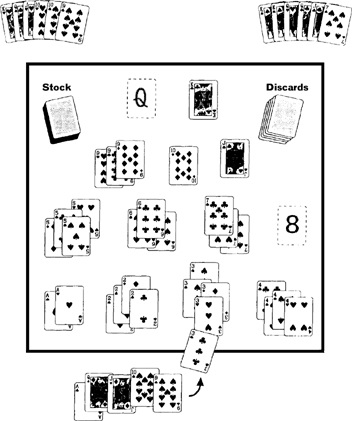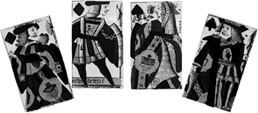The Penguin Book of Card Games: Everything You Need to Know to Play Over 250 Games (92 page)
Read The Penguin Book of Card Games: Everything You Need to Know to Play Over 250 Games Online
Authors: David Parlett

discarded, face down, to a common wastepile. The player adding
the fifth card to the wastepile scores for the zetema before
discarding it. A zetema of Kings or Queens scores 50, Jacks 20, Aces
or Fives 15, other ranks 5 each.

Combinations Upon drawing a card, a player may show and score
for one of the fol owing combinations:
1. Sequence (scores 20). Six cards in sequence, not al the same
suit. For this purpose, cards run A23456789TJQK.
2. Flush (scores 30). Six cards of the same suit, not al in
sequence.
3. Flush sequence (scores 50). Six cards in suit and sequence.
4. Assembly. Five cards of the same rank. An assembly of Kings
or Queens scores 130, Jacks 120, Aces or Fives 110, other
ranks 100.
Having declared one of the above, the player ends his turn by
discarding one of the declared cards to its appropriate
wastepile.
5. Marriage. A marriage is a King and Queen of the same suit.
They may both come from the hand, or one of them may
come from the hand and be matched to a partner lying in the
appropriate discard pile on the table. Kings and Queens may
be col ected quietly and scored simultaneously – the more at
one time, the bet er. One marriage scores 10, two declared
simultaneously score 30, three 60, four 100, al five 150. If
fewer than five are declared, each marriage in the doubled
suit counts an additional ten. Having declared one or more
marriages, the player discards them face up to the common
wastepile (they do not contribute to zetemas), and restores his
hand to six by drawing from the stock. He does not make any
other discard.
If you draw the marriage-partner of a King or Queen forming part
of a six-card combination already in hand, you may not declare that
combination and the marriage in one turn.
End-game If some players run out of cards before others, they
simply stop playing. The whole game ceases the moment anyone

simply stop playing. The whole game ceases the moment anyone
reaches the target score of 200 or 300, even in mid-play. Otherwise,
it ends, very neatly, when the last zetema has been taken and
turned face down to the wastepile, leaving an otherwise empty
table.
Zetema. South discards the fifth Three, scoring 5 for the zetema. The
draw of a King would give a sequence to score on South’s next turn.
Comment Assemblies original y scored 100, 90, 80, 60; but they are
so dif icult to acquire that even with the revisions quoted above
they are rarely worth aiming for. The exceptional y high scores for
King and Queen zetemas are somewhat academic, as neither of
them can ever be completed if so much as a single marriage is
them can ever be completed if so much as a single marriage is
declared.


10 Queen-Jack games
A further variation on the marriage theme occurs in the European
game of Beziqueand its American counterpart, Pinochle. These tend
to simplify the card-point counters almost out of existence,
replacing them with scores for combinations such as sequences and
quartets, whether as original y dealt, or col ected by drawing from a
stock, or counted by the winner of a trick to which the appropriate
cards were played. Their most significant and amusing feature,
however, is their characteristic parodying of the marriage theme by
the introduction of an extra-marital but high-scoring relationship
between a specified Queen and a Jack of the wrong suit – from the
other side of the tracks, so to speak. French researchers trace this
feature back to an old Limousin game cal ed Besi or Besit, though
the stil popular Provencal game of Marjolethas primitive features
that might make it vie for ancestry.
Bezique
2 players, 2 × 32 cards
He… with a shamed and crimson cheek
Moaned ‘This is harderthan Bezique’
Lewis Carrol , The Three Voices (1869)
Bezique is basical y the name of the two-card combination
consisting of Q and J. There are many theories as to its
meaning. Some derive it from bazzica, the Italian for companion,
others from a supposedly Spanish word for a lit le kiss. Its ancestor



others from a supposedly Spanish word for a lit le kiss. Its ancestor
besi or besit means eye-glasses or spectacles. This is also the
meaning of binocle, from which derives pinochle. In the regional
pat ern of cards first used for this game these two figures were the
only ones depicted in profile, thus exhibiting only one eye apiece,
and so two eyes in combination. There could be a hint of voyeurism
in the whole idea.
In another dialect besi means an immature figure, reminding us that
J appears as trickster or a wild card in other old games like
Reversis, Boston and Guimbarde. This role may be of German
origin, as the German equivalent of diamonds is bel s, and bel s are
traditional y
associated with
fools. (‘Pul the other one…’) His partner, Q, has less of a history,
though exhibiting some significance in cartomancy and her role as
Black Maria. Both together formed a winning combination in Hoc,
the court game of Louis XIV, ‘the Sun King’, at Versail es.
Two-pack Bezique, an improvement on its 32-card ancestor,
became a craze in the Paris clubs of the 1840s. It subsequently
spread through the cultural centres of Europe, was first described in
English in 1861, and soon sprouted larger and more elaborate
forms. Like many elaborate games, it has fal en victim to the ever-
increasing need for speed and simplicity, in this case having been
ousted by the vaguely comparable Gin Rummy. Playing-card
manufacturers stil occasional y produce boxed sets containing the
appropriate number of 32-card packs and special y designed
Bezique markers for keeping score, and those with the time and
inclination to pursue the game wil find themselves wel rewarded
by its depth and variety.
